Page 143 of 284
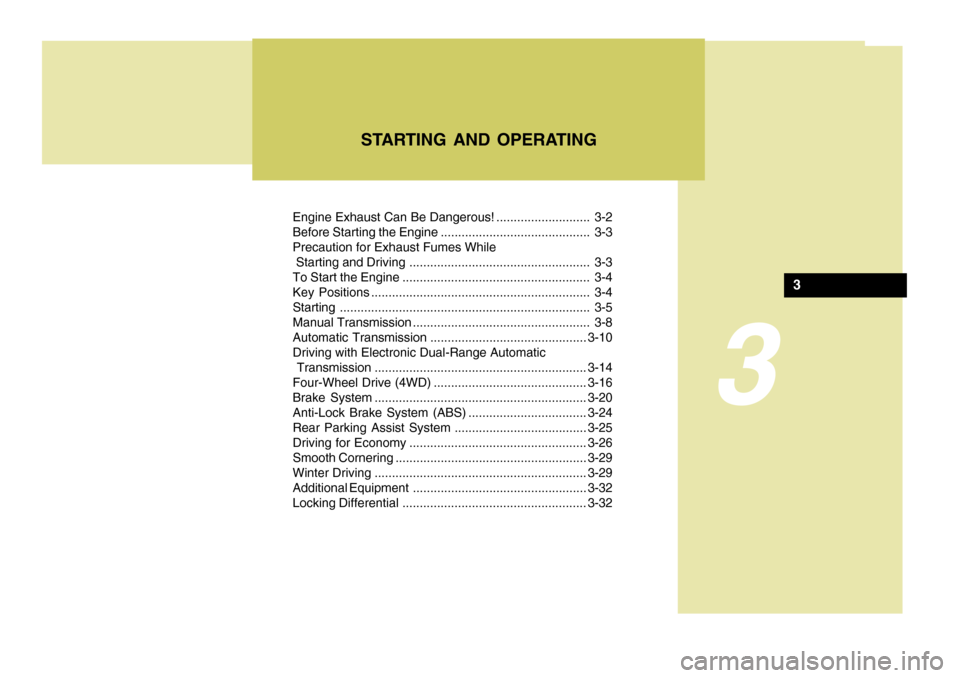
3
Engine Exhaust Can Be Dangerous! ........................... 3-2
Before Starting the Engine ........................................... 3-3Precaution for Exhaust Fumes While
Starting and Driving .................................................... 3-3
To Start the Engine ...................................................... 3-4
Key Positions ............................................................... 3-4Starting ........................................................................ 3-5
Manual Transmission ................................................... 3-8Automatic Transmission ............................................. 3-10
Driving with Electronic Dual-Range Automatic
Transmission ............................................................. 3-14
Four-Wheel Drive (4WD) ............................................ 3-16
Brake System ............................................................. 3-20
Anti-Lock Brake System (ABS) .................................. 3-24
Rear Parking Assist System ...................................... 3-25
Driving for Economy ................................................... 3-26
Smooth Cornering ....................................................... 3-29
Winter Driving ............................................................. 3-29
Additional Equipment .................................................. 3-32
Locking Differential ..................................................... 3-32
STARTING AND OPERATING
3
Page 159 of 284
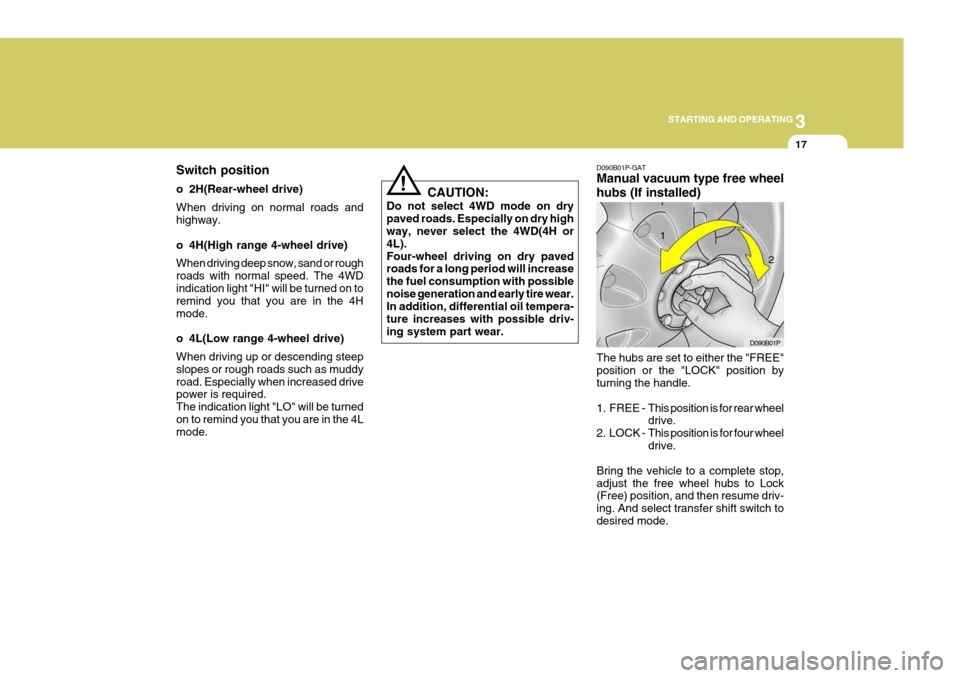
3
STARTING AND OPERATING
17
Switch position
o 2H(Rear-wheel drive) When driving on normal roads and highway.
o 4H(High range 4-wheel drive) When driving deep snow, sand or rough roads with normal speed. The 4WD indication light "HI" will be turned on to remind you that you are in the 4Hmode.
o 4L(Low range 4-wheel drive) When driving up or descending steep slopes or rough roads such as muddyroad. Especially when increased drive power is required. The indication light "LO" will be turnedon to remind you that you are in the 4L mode. CAUTION:
Do not select 4WD mode on dry paved roads. Especially on dry high way, never select the 4WD(4H or 4L).Four-wheel driving on dry paved roads for a long period will increase the fuel consumption with possiblenoise generation and early tire wear. In addition, differential oil tempera- ture increases with possible driv-ing system part wear.
! D090B01P-GAT Manual vacuum type free wheel hubs (If installed) The hubs are set to either the "FREE" position or the "LOCK" position by turning the handle.
1. FREE -
This position is for rear wheel drive.
2. LOCK - This position is for four wheel drive.
Bring the vehicle to a complete stop, adjust the free wheel hubs to Lock (Free) position, and then resume driv- ing. And select transfer shift switch todesired mode. D090B01P
1
2
Page 174 of 284
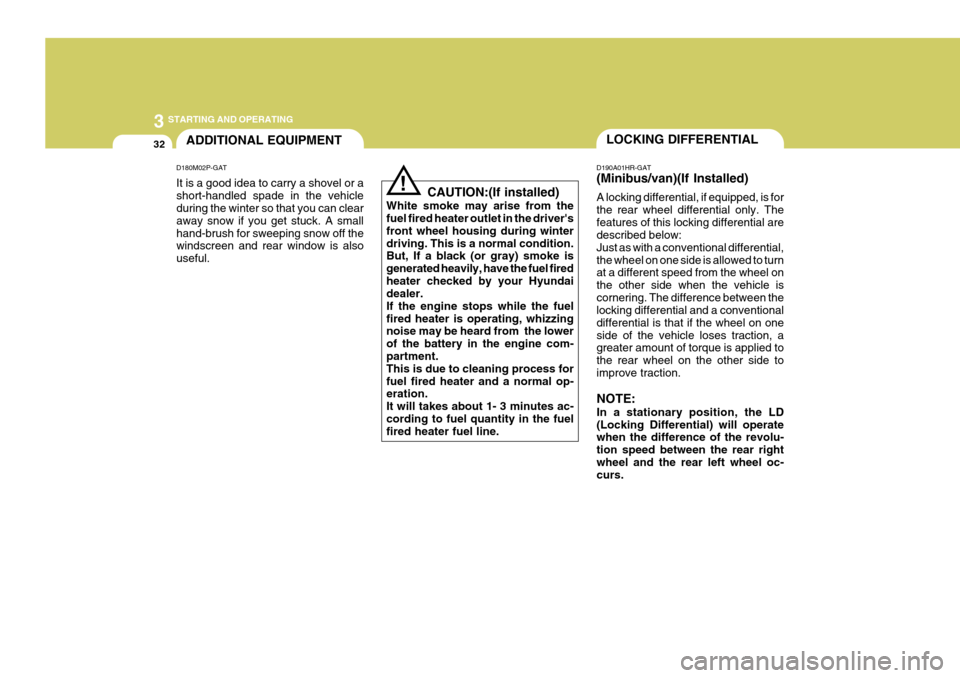
3 STARTING AND OPERATING
32LOCKING DIFFERENTIALADDITIONAL EQUIPMENT
D180M02P-GAT It is a good idea to carry a shovel or a short-handled spade in the vehicle during the winter so that you can clear away snow if you get stuck. A smallhand-brush for sweeping snow off the windscreen and rear window is also useful. D190A01HR-GAT (Minibus/van)(If Installed) A locking differential, if equipped, is for the rear wheel differential only. Thefeatures of this locking differential are described below: Just as with a conventional differential,the wheel on one side is allowed to turn at a different speed from the wheel on the other side when the vehicle iscornering. The difference between the locking differential and a conventional differential is that if the wheel on oneside of the vehicle loses traction, a greater amount of torque is applied to the rear wheel on the other side toimprove traction. NOTE: In a stationary position, the LD (Locking Differential) will operate when the difference of the revolu- tion speed between the rear rightwheel and the rear left wheel oc- curs.
CAUTION:(If installed)
White smoke may arise from thefuel fired heater outlet in the driver's front wheel housing during winterdriving. This is a normal condition. But, If a black (or gray) smoke is generated heavily, have the fuel firedheater checked by your Hyundai dealer. If the engine stops while the fuelfired heater is operating, whizzing noise may be heard from the lower of the battery in the engine com- partment. This is due to cleaning process forfuel fired heater and a normal op- eration. It will takes about 1- 3 minutes ac-cording to fuel quantity in the fuel fired heater fuel line.
!
Page 175 of 284
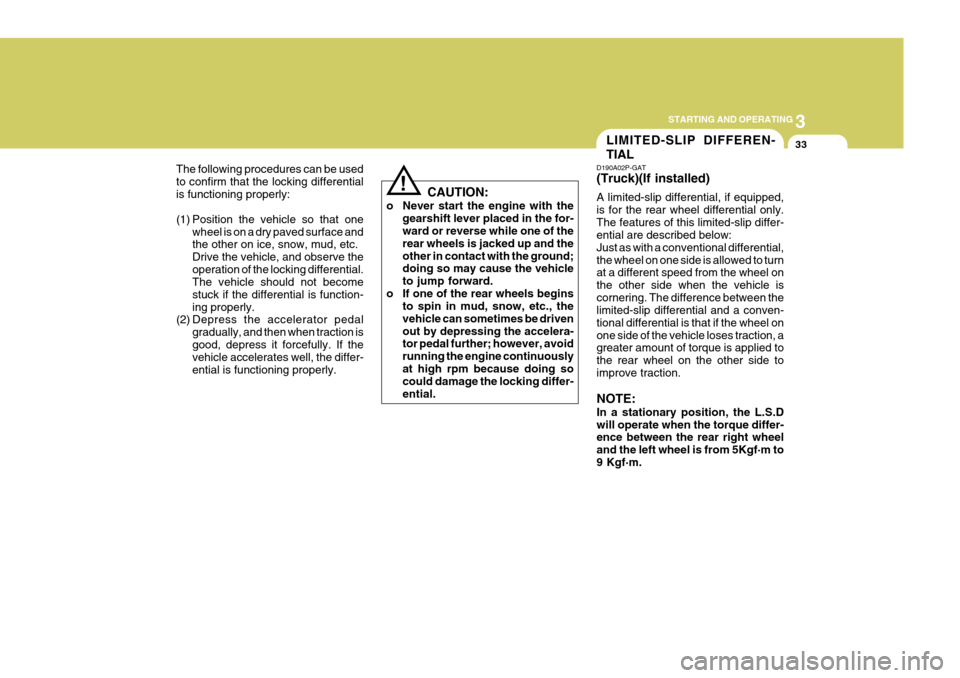
3
STARTING AND OPERATING
33LIMITED-SLIP DIFFEREN- TIAL
CAUTION:
o Never start the engine with the gearshift lever placed in the for- ward or reverse while one of the rear wheels is jacked up and theother in contact with the ground; doing so may cause the vehicle to jump forward.
o If one of the rear wheels begins to spin in mud, snow, etc., thevehicle can sometimes be drivenout by depressing the accelera- tor pedal further; however, avoid running the engine continuouslyat high rpm because doing so could damage the locking differ- ential.
!
The following procedures can be used to confirm that the locking differentialis functioning properly:
(1) Position the vehicle so that one
wheel is on a dry paved surface and the other on ice, snow, mud, etc. Drive the vehicle, and observe theoperation of the locking differential. The vehicle should not become stuck if the differential is function-ing properly.
(2) Depress the accelerator pedal
gradually, and then when traction isgood, depress it forcefully. If the vehicle accelerates well, the differ- ential is functioning properly. D190A02P-GAT
(Truck)(If installed) A limited-slip differential, if equipped, is for the rear wheel differential only.The features of this limited-slip differ- ential are described below: Just as with a conventional differential,the wheel on one side is allowed to turn at a different speed from the wheel on the other side when the vehicle iscornering. The difference between the limited-slip differential and a conven- tional differential is that if the wheel onone side of the vehicle loses traction, a greater amount of torque is applied to the rear wheel on the other side toimprove traction. NOTE: In a stationary position, the L.S.D will operate when the torque differ- ence between the rear right wheel and the left wheel is from 5Kgf·m to9 Kgf·m.
Page 176 of 284
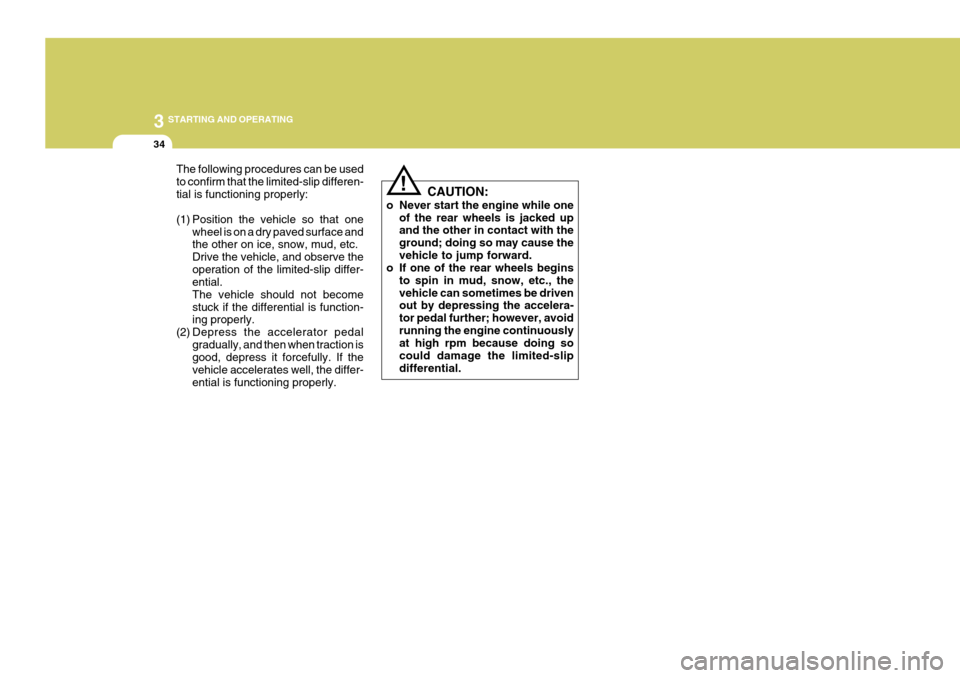
3 STARTING AND OPERATING
34
!
The following procedures can be used to confirm that the limited-slip differen-tial is functioning properly:
(1) Position the vehicle so that one
wheel is on a dry paved surface and the other on ice, snow, mud, etc. Drive the vehicle, and observe theoperation of the limited-slip differ- ential. The vehicle should not becomestuck if the differential is function- ing properly.
(2) Depress the accelerator pedal gradually, and then when traction isgood, depress it forcefully. If the vehicle accelerates well, the differ-ential is functioning properly. CAUTION:
o Never start the engine while one of the rear wheels is jacked up and the other in contact with the ground; doing so may cause thevehicle to jump forward.
o If one of the rear wheels begins
to spin in mud, snow, etc., thevehicle can sometimes be driven out by depressing the accelera- tor pedal further; however, avoidrunning the engine continuously at high rpm because doing so could damage the limited-slipdifferential.